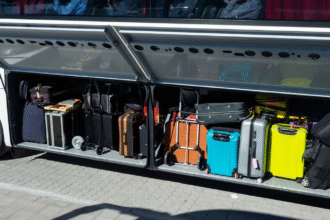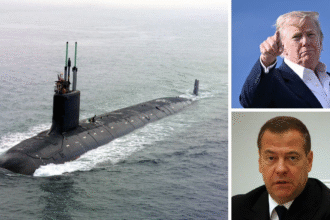hrvarts, Tensions in the Middle East reached a new boiling point as thousands of Tehran residents fled the capital Wednesday morning following fresh missile exchanges between Israel and Iran and a veiled threat by U.S. President Donald Trump to potentially join Israel in targeting Iran’s nuclear infrastructure.
As Israeli jets bombed strategic sites across Tehran overnight, President Trump declared on social media that Iran should surrender unconditionally, stoking fears of imminent U.S. intervention.
Tehran Residents Ordered to Evacuate, Fuel Rationing Begins
Israel issued warnings to civilians in southwest Tehran to evacuate, signaling its intention to target Revolutionary Guard military facilities. Iranian state media reported heavy traffic congestion as residents fled toward the Alborz Mountains and northern provinces. To manage shortages, fuel rations were introduced, though Oil Minister Mohsen Paknejad assured there would be no disruption to public supply.
Israel Steps Up Strikes on Iranian Soil
According to Israeli military officials, 50 fighter jets conducted overnight operations, striking 20 high-value targets in Tehran and eastern Iran. These included missile manufacturing sites, raw material processing plants, and the Khojir ballistic missile complex.
Iranian media also reported that a university linked to the Revolutionary Guards was hit, and clashes erupted in Rey, south of Tehran, between Iranian security forces and unidentified gunmen suspected to be linked to Israel.
Iranian Death Toll Stagnates as New Casualties Mount
Iran’s official death toll of 224 mostly civilians has not been updated for days, despite new waves of airstrikes. Iranian missile retaliation has so far killed 24 civilians in Israel, with over 400 rockets fired in total. Israeli authorities confirmed that 40 rockets breached air defenses, hitting Tel Aviv, Haifa, and surrounding areas.
Explosions continued to rock Israeli cities early Wednesday, with reports of significant damage to residential zones.
Trump’s Cryptic Signals Raise Global Alarm
President Trump’s remarks on his Truth Social platform have left both allies and adversaries uncertain. In a series of posts, he wrote:
“We know exactly where the so-called ‘Supreme Leader’ is hiding. We are not going to take him out (kill!), at least not for now … Our patience is wearing thin.”
Followed minutes later by: “UNCONDITIONAL SURRENDER!”
According to a senior source familiar with internal White House discussions, Trump met with the National Security Council on Tuesday and is actively considering joining Israel’s campaign, potentially using American bunker-busting munitions to strike deep sites like Iran’s Fordow nuclear facility, which is heavily fortified under a mountain.
Trump also reportedly spoke with Israeli Prime Minister Benjamin Netanyahu and held extensive consultations on military coordination.
Israel Gains Control Over Iranian Airspace
Israeli officials claim that their forces have neutralized Iranian air defenses and now maintain temporary control of Iranian airspace, allowing for deep strikes without resistance. They confirm that the Natanz nuclear enrichment plant has sustained direct damage.
Still, Israeli officials admit that complete destruction of underground facilities like Fordow is only achievable with U.S. military support.
International Reactions and Diplomatic Fallout
British Prime Minister Keir Starmer, speaking from the G7 summit in Canada, said there was no immediate sign of U.S. entry into the war but warned that “the world stands on the edge of catastrophe.”
Global markets reacted swiftly. Crude oil prices surged on fears of supply disruption, while Asian currencies and equities showed mixed responses to news of U.S. fighter jet deployments to the region.
Meanwhile, Iran’s cybersecurity authority has banned high-ranking officials from using mobile phones or personal communication devices due to ongoing Israeli cyber offensives.
Strategic Fallout for Iran’s Leadership
Five sources close to Iran’s Supreme Leader Ayatollah Ali Khamenei revealed that key military and intelligence advisors have been killed, destabilizing internal command structures. These losses represent the biggest security breach since the 1979 Islamic Revolution.
The damage extends to Iran’s regional alliances. With Hamas in Gaza, Hezbollah in Lebanon, and militias in Iraq and Syria weakened by Israeli precision strikes, Iran’s influence in the region is unraveling.
Even Iran’s long-standing ally, Syrian President Bashar al-Assad, has reportedly been overthrown in a sudden coup amid regional chaos.
What’s Next?
Netanyahu remains steadfast, declaring:
“We will not stop until Iran’s nuclear threat is permanently neutralized.”
President Trump, meanwhile, continues to oscillate between threats and diplomacy, leaving U.S. involvement ambiguous yet increasingly probable.
The UN’s International Atomic Energy Agency (IAEA) confirmed that Israeli strikes hit enrichment facilities at Natanz, and warned that further attacks could lead to an uncontrolled nuclear incident.
Iran continues to deny developing nuclear weapons, citing its rights under the Non-Proliferation Treaty (NPT). However, the Iranian parliament is preparing legislation to exit the treaty altogether, in a move that would shock international diplomacy and signal Iran’s defiance.
With civilians evacuating Tehran, missile fire intensifying, and Trump potentially joining Israel’s campaign, the Middle East stands on the edge of a conflict that could reshape global power structures. While world leaders scramble for diplomacy, the machinery of war is moving fast perhaps too fast to stop.






